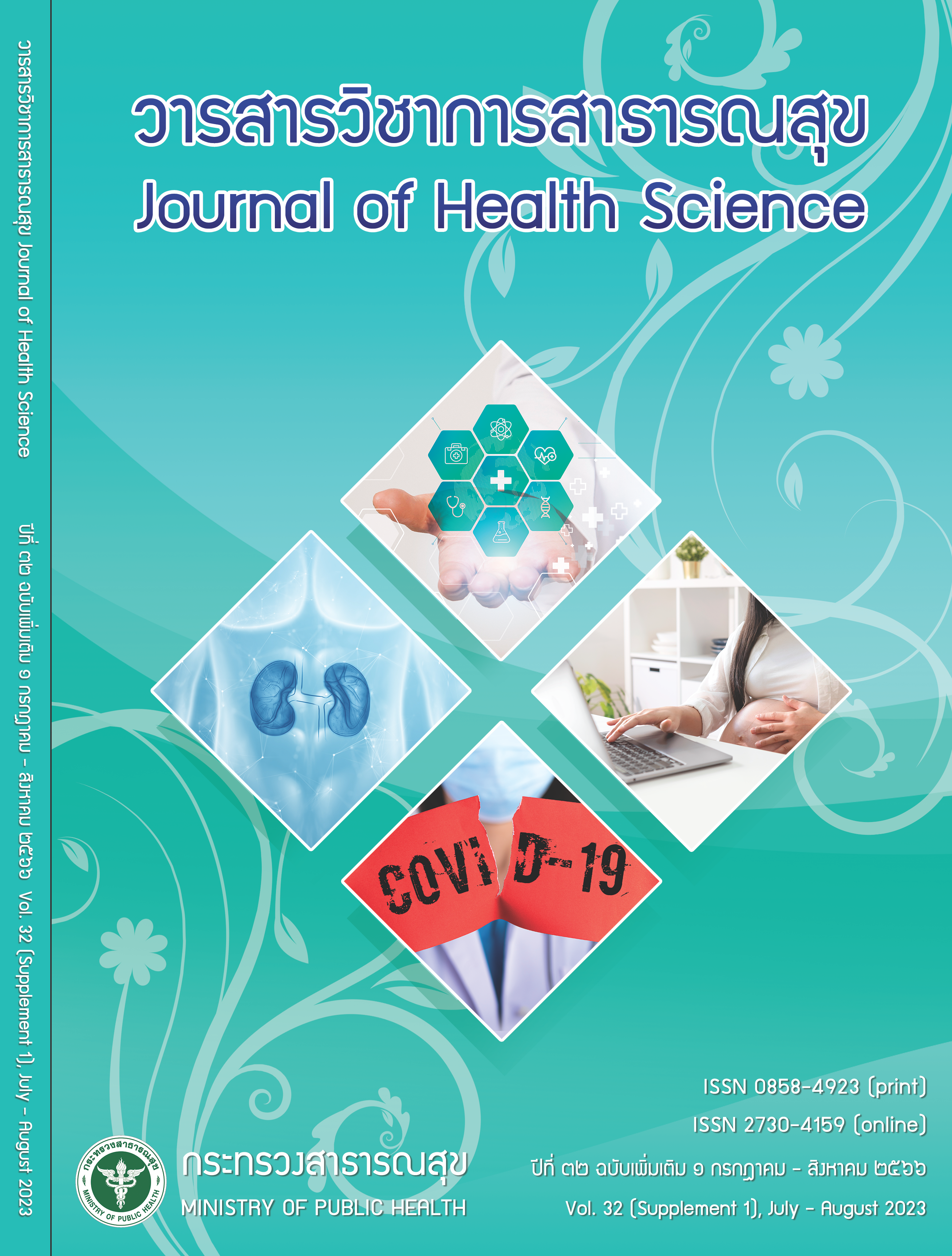Outcomes of Clinical Nursing Practice Guideline Implementation for Promoting Success Weaning in Difficult Weaning Patients in Neurocritical Intensive Care Units
Keywords:
clinical nursing practice guideline, promoting success weaning, difficult weaning, ventilator associated pneumoniaAbstract
The objective of this study was to assess the outcomes after the implementation of clinical nursing practice guideline (CNPG) for promoting success weaning in difficult weaning patients. It was conducted in a neurocritical intensive care unit. The clinical nursing practice guideline developed by the National Health and Medical Research Council, Australia, was applied to compare the outcomes before-and-after the implementation of the guideline. The samples were 102 patients who admitted in a neurosurgical intensive care unit. They were categorized into 2 groups: 51 retrospective patients and 51 prospective ones;a dndata were collected accordingly. The outcomes measured were (1) the success weaning of mechanical respirators, (2) duration of weaning mechanical respirators, (3) the ventilator associated pneumonia (VAP) rate, (4) the re-intubation rate, and (5) the length of stay. All data were recorded in a nursing documentation form as a routine respiratory care standard, and were were analyzed by using mean, standard deviation, percentage, Chi-square, and independent t-test. It was found that, after using the clinical nursing practice guidelines, the weaning success was statistically significantly higher than before (p<0.05). The number of patients with success weaning increased from 72.5% (37 cases) to 94.1% (48 cases). The rate of ventilator associated pneumonia (VAP) was reduced from 19.6% (10 cases) to 3.9% (2 cases). After the implementation, the success rate was high in both groups, namely in 38 difficult weaning patients (74.5%) and 13 prolonged weaning patients (25.5%). However, before and after of the re-intubation rate increased from 13.7% (7 cases) to 17.60% (9 cases), length of weaning ventilator increased from 6.2±4.6 days to 6.6±5.6 days), and length of stay in ICU decreased from 13±8.6 days to 11.9±8.1 days, although there were not significantly different (p>0.05). In conclusion, it is suggested to apply the clinical nursing practice guideline for improving weaning success in patients with difficulty weaning in order to reduce VAP and increased weaning success rate
Downloads
References
Helmy A, Vizcaychipi M, Gupta, AK. Traumatic brain injury: intensive care management. British Journal of Anaesthesia 2007;99(1):32–42.
Tumul C, Stephen K, Yaseen A, Hari H. General intensive care for patients with traumatic brain injury: an update. Saudi Journal of Anesthesia 2014;8(2):256-62.
Jaber S, Petrof BJ, Jung B, Chanques G, Berthet JP, Rabuel C, et al. Rapidly progressive diaphragmatic weakness and injury during mechanical ventilation in humans. American Journal of Respiratory and Critical Care Medicine 2011;183(3):364-71.
Kalle H, Chelly H, Bahloul M, Ksibi H, Dammak H, Chaari A, et al. The effect of ventilator-associated pneumonia on the prognosis of head trauma patients. J Trauma 2005;59:705-10.
รุ่งทิพย์ ดารายนต์. ประสบการณ์ของผู้ป่วยที่มีความยาก ลำบากในการหย่าเครื่องช่วยหายใจ [วิทยานิพนธ์พยาบาลศาสตร์มหาบัณฑิต สาขาการพยาบาลผู้ใหญ่]. สงขลา: มหาวิทยาลัยสงขลานครินทร์; 2551.
ประณีต ส่งวัฒนา. คุณภาพและผลลัพธ์ในการดูแลผู้ป่วยที่ ใช้เครื่องช่วยหายใจเป็นระยะเวลานาน. ใน: สุนิสา ฉัตรมงคลชาติ, ธันต์ชนก วนสุวรรณกุล, ประณีต ส่งวัฒนา, บรรณาธิการ. Respiratory care: การพัฒนาคุณภาพในการ ดูแลผู้ป่วยที่ใช้เครื่องช่วยหายใจเป็นเวลานาน. สงขลา: ชานเมืองการพิมพ์; 2550. น. 67-84.
โรงพยาบาลหาดใหญ่, หอผู้ป่วยหนักศัลยกรรมประสาท. สถิติข้อมูลหอผู้ป่วยหนักศัลยกรรมประสาทปี พ.ศ.2558- 2559. สงขลา: โรงพยาบาลหาดใหญ่; 2560.
ขนิษฐา อรัญดร, นฤมล อนุมาศ, สุปนิตา สังข์แก้ว. ผลการ หย่าเครื่องช่วยหายใจในผู้ป่วยวิกฤตศัลยกรรมประสาท. วารสารวิชาการเขต 12 2558;26:53-8.
National Heatlh and Medical Research Council. A guide to the development, implementation and evaluation of clinical practice guidelines. Canberra: National Health and Medical Research Council; 1998.
ขนิษฐา อรัญดร, นฤมล อนุมาศ, ชมนภัส รัตติโชติ, ประณีต ส่งวัฒนา. การพัฒนาและประเมินผลการใช้แนวปฏิบัติการ พยาบาลหย่าเครื่องช่วยหายใจยากในผู้ป่วยวิกฤติศัลยกรรม ประสาท วารสารวิชาการเขต 12, 2561;26:52-8.
Beduneau G, Pham T, Schortgen F, Piquillound L, Zogheib E, Jonas M, et al. Epidemiology of weaning outcome according to a new definition. The WIND Study. American Journal of Respiratory and Critical Care Medicine 2017;195(6):772-83.
Senguta S, Chakravarty C, Rudra A. Evidence-based practice of weaning from ventilator: a review. London: World Federation of Societies of Anesthesiologists; 2018.
The Joanna Briggs Institute. The Joanna Briggs Institute reviewers’ manual 2014. Adelaide: The Joanna Briggs Institute; 2014.
Heunks LM, Van der Hoeven JG. Clinical review: the ABC of weaning failure-a structure approach. Crttical Care 2010;14(6):245.
สรภพ ภักดีวงศ์. High-flow nasal cannular. ใน: ดุสิต สถาวร, ครรชิต ปิยะเวชวิรัตน์, สัณฐิติ โมรากุล, บรรณาธิการ. Covid and crisis in critical care. นนทบุรี: บียอนด์ เอ็นเทอร์ไพรซ์; 2563. หน้า 13-9.
Maggiore SM, Idone FA, Vaschetto R, Festa R, Cataldo A, Antonicelli F. Nasal high-flow versus venturi mask oxygen therapy after extubation. Effects on oxygenation, comfort, and clinical outcome. Am J Respir Crit Care Med 2014;190(3):282-8.
Hermandez G, Vaquero C, Colinas L, Cuena R, Gonzalez P, Canabal A. Effect of postextubatetion high flow nasal cannula vs noninvasive ventilation on reintubation and postextubation respiratory failure in high-risk patients: a randomized clinical trial. JAMA 2016;316(15):1565- 70.
Cresci G, Cue JI. Nutrition support for the long-term ventilator-dependent patient. Respir Care Clin N Am 2006;12:567-91.
รังสรรค์ ภูรยานนทชัย. การให้โภชนบำบัดในผู้ป่วยวิกฤต. สงขลานครินทร์เวชสาร 2549;24:425-43.
Hinrichs M, Huseboe J. Research-based protocol management of constipation. Journal of Gerontological Nursing 2001;27(2):17-28.
Mostafa SM, Bhandari S, Ritchie G, Gratton N, Wenstone R. Constipation and its implications in the critically ill patient. British Journal of Anaesthesia 2003;91(6): 815-19 .
Dessap AM, Roche-Campo F, Kouatchet A, Tomicic V, Beduneau G, Sonneville R, et al. Natriuretic peptide– driven fluid management during ventilator weaning a randomized controlled trial. Am J Respir Crit Care Med 2012;186(12):1256–63.
Klompas M, Li L, Kleinman K, Szumita PM, Massaro AF. Associations between ventilator bundle components and outcomes. JAMA Internal Medicine 2016;176(9): 1278-83.
Rollnik JD, Krauss JK, Gutenbrubber C, Wallesch C, Munte T, Stangel M. Weaning of neurological early rehabilitation patients from mechanical ventilation: a retrospective observational study. European Journal of Physical and Rehabilitation Medicine 2017;53(3):441- 6.
Walterspacher S, Guckler J, Pietsch F, Walker DJ, Kabitz HJ, Dreher M. Activation of respiratory muscles during weaning from mechanical ventilation. Journal of Critical Care 2017;38:202-8.
Downloads
Published
How to Cite
Issue
Section
License

This work is licensed under a Creative Commons Attribution-NonCommercial-NoDerivatives 4.0 International License.







